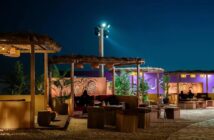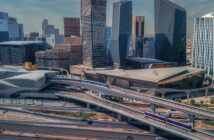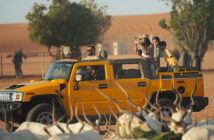By Alex Woodman
If you’re looking for a myriad of adventures in Saudi Arabia, that includes history, culture, and nature to arts, entertainment, and leisure, there’s only one way to go… to the Eastern Province.
The history of the Eastern Province of the Kingdom of Saudi Arabia dates back to the era of Dilmun and Magan about 5000 years ago. The province’s countryside is rich with natural springs, oil wells, unique plants, and the unique scenic area which surrounds the sea. Interestingly, since ancient times, the Eastern Province has differed from the other provinces of the Kingdom in its architectural style, building constructions, and the original shape of older cities. This is demonstrated in traditional narrow streets with terrace houses, palm fronds constructions, mud, and robust old wood used to construct the roofs of the houses. The modern Eastern Province can be explored through its central oasis and the developing cities of Dammam, Al–Khobar, Qatif, and al–Hasa.
The Dammam Metropolitan Area or Greater Dammam Dhahran is the administrative center of the Eastern Province, which along with Al–Khobar and Dammam, form what is known as the Dammam Metropolitan Area or the Greater Dammam. As the capital of the Eastern Province, Dammam is located on the road which intersects the Arabian Gulf States: the Kingdom of Bahrain, the State of Kuwait, the State of Qatar, the Sultanate of Oman, the UAE, and the Kingdom of Saudi Arabia.
According to legend, the name Dammam is derived from a tradition of knocking on drums to alert the people of imminent danger. It was also used when it was time to meet the fishermen returning from the sea. Among the most ancient sites and antiquities of Dammam, remains the Western Raka with its 160 burial places, dating back to the first century. One can also find unique constructions and monumental buildings from the pre-Islamic period in Northern Raka. Nowadays, Dammam has grown from a small fishing village to a major commercial port in the Gulf and is considered to be a modern city.

Saudi Aramco, one of the largest oil companies in the world, is also one of the most profitable. Its success is related to the discovery of Dammam Well #7, in 1938. Since that time, Saudi Aramco began its production of commercial quantities of oil. The well is located on a hill named Jabal Dhahran near an uncommon cluster of peaks called Umm al–Rus. Currently, the King Abdulaziz Center for World Culture (Ithra) is located near the Prosperity Well; an area in the region where oil was first discovered in commercial quantities.
The construction of Ithra was initiated by Saudi Aramco; formerly the Arabian-American Oil Company, and inaugurated by King Salman on 1 December 2017. The highlight of Ithra is to offer a comprehensive view of the culture of Saudi Arabia and the different phases of its historical development. The Ithra Center is ninety meters high and covers an area of 45,000 square meters. The Knowledge Tower overlooks the surrounding facilities, which were expected to become a pioneering hub of science and technology in the region. It has also encouraged pride in the community and has as one of its goals to create a knowledge-based economy in the country.
Al–Khobar, often referred to as the Gulf Pearl or the Bride of the Eastern Province, is a visually attractive area, with its Corniche, spreading from the Half Moon Bay through Aziziyah beach to Dammam city. Al–Khobar is one of the most progressive, attractive, and economically developed cities in the Middle East and the Gulf Cooperation Council.

Half Moon Bay is another exceptionally idyllic site, known for its stunning cover of golden sand, extending twenty-five kilometers along the coast. The climate of the Bay brings with it the warm desert waves which are perfect for all types of water sports; especially diving and searching for the sea inhabitants. The Eastern Province is considered one of the most magnificent places for diving. Many believe that the beauty of its waters and coral reefs, its numerous sea creatures, and vibrant marine life is the highlight of this location. Historically, the earliest divers collected pearls and celebrated their discoveries at the annual pearl collecting festival.
The Al–Khobar Waterfront overlooks the urban life of the city. After some time, the area of the Waterfront was converted into a park; soon named in honor of Prince Faisal bin Fahad. The park remains an expansive green area of 500,000 square meters, spreading along the Al–Khobar East coastline. The place is cherished by the residents and considered to be the heart of Al–Khobar city.
Eventually, the outstanding feature of Dammam and Al–Khobar is the King Fahd Causeway; built in 1984. The King Fahd Causeway is a series of bridges and causeways connecting Saudi Arabia and Bahrain and spans a distance of twenty-five kilometers. It is the longest bridge in the Middle East and has three lanes for cars; each with contemporary security checkpoints. The idea of constructing the causeway was initiated to improve the links and bonds between Saudi Arabia and Bahrain.
Must-Visit Restaurants
● Al Sanbok Seafood Restaurant is an internationally-acclaimed restaurant by the sea. It serves local and Mediterranean cuisines and uses the freshest seafood in their dishes.
● Khobar Traditional Village mixes old Islamic architecture with modern touches and serves Middle Eastern cuisine. The same ambiance can also be found in the Heritage Village.
Must-Visit Places
● Apart from the triumvirate cities of Dammam, Dhahran, and Al Khobar, nearby Jubail and Ras Ta Nura are also worth visiting. Their corniches and parks are nice for family picnics. Their beaches are clear and sparkling.




